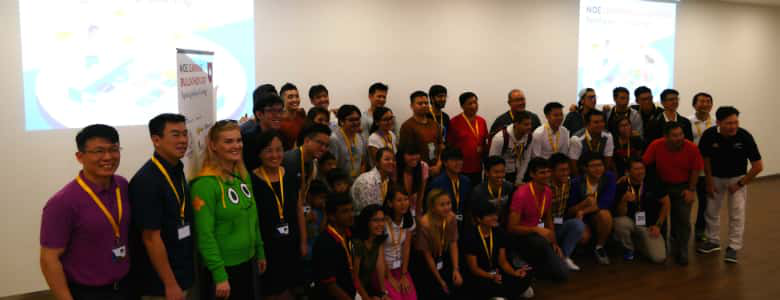A Buildathon for the Future of Education

It’s not every weekend that you see educators working hand-in-hand with techies to develop tech prototypes and demos.
A ‘sand box’ model that triggers off a virtual reality software, when children start to move the mountain. Chatbots that can help students to pick up the Chinese language, coach them in physics, or discuss a General Paper article a day.
Just some of the exciting — and wacky — projects built by the diverse teams taking part in the MOE Learning Buildathon.
Buzzing Buildathon
Happening over the weekend of 25 and 26 March 2017, the Buildathon was a — you guessed it — hackathon that aimed to inspire innovate tech tools that ‘encouraged and enabled’ learning that is fun and fulfilling, in the languages, STEM (Science, Technology, Engineering and Mathematics), the Humanities and Arts.
The event was a collaboration between GovTech and the Ministry of Education, and it sought to unlock the power of crowdsourcing of the best ideas.
Mr Tan Bee Teck, Chief Information Officer (CIO) of MOE, kickstarted the day by encouraging participants to unlock the Joy of Learning— which was the Buildathon theme — through the tech ideas they had.
The Learning Buildathon, which was initiated by Mr Tan, was inspired by the vibrant startup ecosystem observed in Slush last year.
Mr Tan said: “We hoped that through the Learning Buildathon, people of multidisciplinary skills would be brought together, build upon each other’s ideas, co-create solutions and therefore enable new possibilities for learning using technology.”
And judging by the dynamic way in which virtual strangers — including veteran educators, trainee teachers, polytechnic students and tech developers including one GovTechie — gelled together to form highly-driven teams during the Buildathon, it can be argued that it was mission accomplished.
Professional advice
The teams benefitted from the wisdom of several tech professionals who helped out as mentors.
One such mentor, Mr Lauri Jarvilehto, CEO of Finnish tech firm Lightneer, was on hand to give a pep talk to the participants on Day One. Lightneer, which counts several former employees of Rovio Entertainment — of Angry Birds fame — in its team, focusses on developing fun learning games.
Mr Jarvilehto was optimistic about tech in education, saying: “We are building things nobody thought was possible before.”
Lighneer’s new game, Big Bang Legends, came about because ‘we wanted to teach quantum physics to 5-year olds.”
And he shared Lightneer’s philosophy: “Learning is fun, learning takes work, and there are no stupid people.”
Why should learning take work, one might ask?
Said Mr Jarvilehto: “Fun does not equal easy. Learning has to make you work to give you the feeling of growth. You wouldn’t play an easy game for long, would you?”
Fun but hard could also summarise the Buildathon experience for the participants, as they worked hard on their projects on a tight deadline — the top 20 teams had to present their ideas in a final pitching session on Sunday.
Winning Pitch
Only the top ten teams that survived the final pitching round could make it through to the Finals, to be held on 31 March at the MOE ExCEL Fest.
To make the challenge tougher, each team had just three minutes to wow the judging panel: Ms Tan Chen Kee, Divisional Director at MOE, Ms Hanna Toivonen from Lightneer, and Mr Gary Lim, Senior Director at Microsoft.
With support and advice from the mentors like Lightneer’s Mr Jarvilehto and Mr Peter Vesterbacka (better known as ‘Mighty Eagle’ to Angry Birds fans), it was no surprise that the presenting teams were full of confidence and enthusiasm.
One example was Team Explorer, with an app that uses image recognition technology to let students explore their environments.
Team leader Mr Lee Ming Yew, an Education Technology Officer, said: “Peter sat down with us and advised us to simplify our app, to take the main feature and make that the focus instead of trying to do many things. In other words, do one thing and do it well.”
The advice evidently worked, as Team Explorer made it to the Finals. This means that Team Explorer, like the other finalists, will get its solution looked at by MOE divisions — with the potential to be fully developed and translated into actual learning solutions.
Another competitor, Team Whaddat, which had a similar idea that also incorporated videos and data analytics, benefited from a half-an-hour session with Mr Jarvilehto, who advised them to widen their target audience beyond just young kids aged 5 to 8 years old.
Although the team did not make it to the Finals, team leader Lewis Thong, an educator, told TechNews: “We all shared a common passion for education. It’s not about the winning. We intend to continue working on our idea together because we believe in it.”
And that, in a nutshell, symbolised the spirit of the MOE Learning Buildathon.
https://www.tech.gov.sg/media/technews/a-buildathon-for-the-future-of-education
